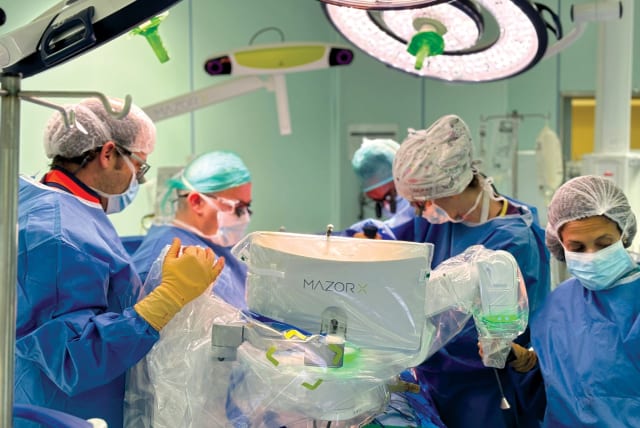New rehab center opens at Jerusalem's Hadassah hospital

Until the center opened last month, Jerusalem had a shortage of rehab beds. The new center will have 132 beds and will be able to treat 10,000 patients a year.
Assaf, a battalion commander in Gaza, was on a search-and-destroy mission in Gaza to find tunnel shafts when he was shot in his elbow. In civilian life Assaf, 42, works in the Prime Minister’s Office. (He did not give his last name for security reasons.)
“I was bleeding a lot from my elbow, and I gave an order to put a tourniquet on my arm,” Assaf told The Jerusalem Report during a tour of Hadassah Medical Center’s new rehabilitation unit. “Then one of my soldiers came with his tank to evacuate me. They tried to carry me to the tank, and I said, ‘Back off. I’m walking by myself to the tank. I need everybody to see that I’m still walking.’”
He was taken to Soroka Medical Center at first. Two days later, he was moved to Hadassah Ein Kerem, where he had surgery, and plates and screws were placed in his arm. He was then transferred to the newly opened Gandel Rehabilitation Center.
“It’s very intense,” he said. “I have physical therapy, occupational therapy, and all kinds of other therapies in order to gain back what I lost in my abilities and my elbow.”
The challenges of rehab during war
Until the center opened last month, Jerusalem had a shortage of rehab beds. The new center will have 132 beds and will be able to treat 10,000 patients a year. There is also an underground hospital if needed during wartime.
The center uses the latest therapies, such as the anti-gravity machine to help people learn to walk again. It has helped 21-year-old Raphael, who was wounded in his leg, to be able to climb steps and regain almost full function.
Raphael, a Givati soldier, called his mother from Soroka and told her he had a “scratch” on his leg. “But I knew they don’t evacuate soldiers out of Gaza for a scratch,” she said. Rafael is working hard on his rehab with the help of a cutting-edge machine made by NASA that enables patients to practice walking even with severe leg injuries. His room at home in Jerusalem is up several flights of stairs. At the beginning, it seemed impossible that he would be able to make it up to his room at home. But just a few months later, he easily climbs the steps.
The Israeli government says that almost 10,000 Israelis have been wounded in the war, and thousands of soldiers require rehabilitation. In this war, more soldiers are surviving serious wounds than ever before. Israel says it has made changes in its fighting doctrine that are keeping more soldiers alive even if they are severely wounded. There are more doctors in the field with combat soldiers than previously, and they have learned to evacuate wounded soldiers more quickly.
Bezalel Bazak, 45, a physicist in Jerusalem, says he was evacuated in less than an hour from the time he was wounded in Gaza. “That’s what saved my life,” he told The Jerusalem Report as he played what looked like a video game. “You need to build back your force, your ability to walk, to run. It takes some time, and today in a way of playing instead of just doing exercise more and more times. It’s fun.”
There have also been advances in surgical techniques that are less invasive and allow for a faster recovery. These include using robots to perform some surgeries.
“We had a guy who had a bullet stuck in his spine that was dangerous because it was sitting on one of the nerves,” Dr. Joshua Schroeder, head of the Spine Unit at Hadassah, said. “In the old days, you would have to open him up completely to take it out; but now with robotic technology, all we had to do was make a small five-centimeter incision and take it out.”
He said that robots offer some advantages over human beings, but they also have limitations. “Where we use robots in spinal surgery is for putting in screws, putting in cages, things that are routine,” he said. “We want to make sure we have a sub millimeter accuracy where we’re placing it to avoid the dangerous structures in the body. Other aspects that are more dynamic, such as looking at the patient as he’s moving along, the robots are not yet at that level of development.”■
Jerusalem Post Store
`; document.getElementById("linkPremium").innerHTML = cont; var divWithLink = document.getElementById("premium-link"); if (divWithLink !== null && divWithLink !== 'undefined') { divWithLink.style.border = "solid 1px #cb0f3e"; divWithLink.style.textAlign = "center"; divWithLink.style.marginBottom = "15px"; divWithLink.style.marginTop = "15px"; divWithLink.style.width = "100%"; divWithLink.style.backgroundColor = "#122952"; divWithLink.style.color = "#ffffff"; divWithLink.style.lineHeight = "1.5"; } } (function (v, i) { });

